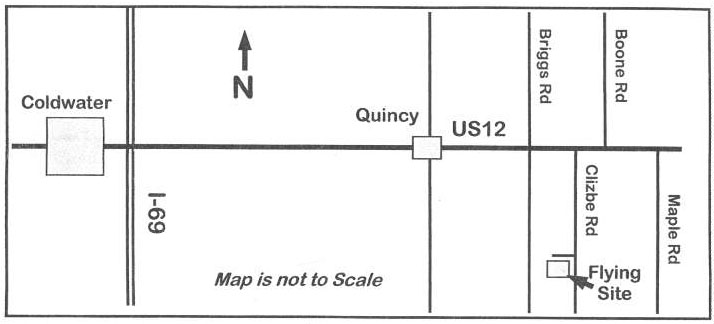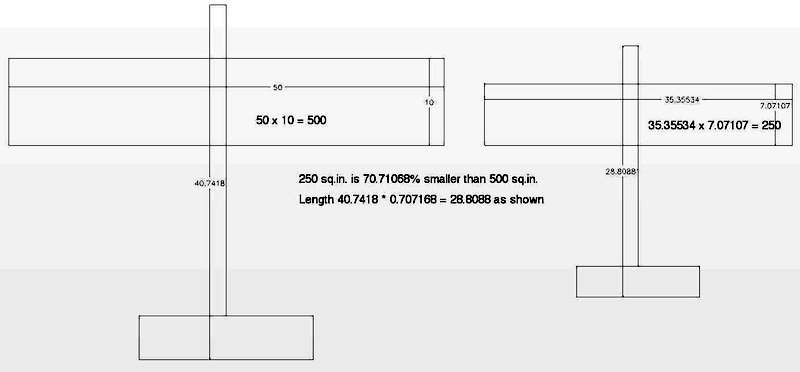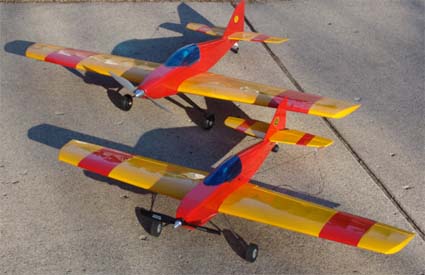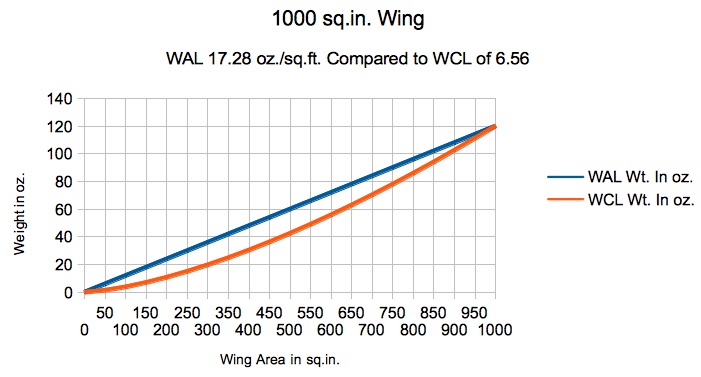 |
Flying High With Electric Power!
The Ampeer ON-LINE!
Fly the Future - Fly Electric! |
|---|
Site Table of Contents
| President: | Vice-President: | Secretary-Treasurer: |
| Ken Myers | Richard Utkan | Rick Sawicki |
| 1911 Bradshaw Ct. | 240 Cabinet | 5089 Ledgewood Ct. W. |
| Commerce Twp., MI 48390 | Milford, MI 48381 | Commerce Twp., MI 48382 |
| (248) 669-8124 | (248) 685-1705 | (2480 685-7056 |
 | ||
| Board of Directors: | Board of Directors: | Ampeer Editor |
| David Stacer | Arthur Deane | Ken Myers |
| 16575 Brooklane Blvd. | 21690 Bedford Dr. | 1911 Bradshaw Ct. |
| Northville, MI 48168 | Northville, MI 48167 | Commerce Twp., MI 48390 |
| (248) 924-2324 | (248) 348-2058 | (248) 669-8124 |
| EFO Flying Meeting: Saturday, June 19 Time: 10 a.m.
Place: Midwest RC Society 7 Mile Rd. flying field | ||
| Wing Cube Loading (WCL) Update for 2018 An update on the value of using wing cube loading instead of wing area loading when trying to compare flyability of different planes. | Upcoming Keith Shaw Birthday Party Electric Fly-in 2018 Event announcement |
| Skymasters' Electric Night Fly and Fly-in Event announcement | Upcoming 34th Annual Mid-America Electric Flies 2018 Great Event Announcement |
| The table shows the planes and types arranged by wing area loading (WAL) on the left and WCL on the right.
It is interesting to note what happens to Bob's order, which uses WAL, when it is compared to the WCL method of organizing planes by their 'flyability' level. It is also interesting to note that the "flyability" order doesn't go as expected or predicted by Bob. If you have experienced flying some of these or similar models, you should be able to see that using the WCL comparative value, shown in the right column, gives a more realistic idea about the relative ease of flight of the various models. For many years I have collected data for propeller driven model aircraft using glow, gas and electric power systems. I have archived and analyzed that data in an Excel workbook with several spreadsheets. The Excel workbook is available and may be downloaded to your computer by clicking here. Based on the collected data, I have created seven WCL levels. The levels reflect the "ease" of flying and ability required to fly them. Some planes won't work in a given physical environment, where I've used a physical description, but they fly like others in the level. Not all aircraft will fit the title or level grouping I have given. An example that doesn't fit the physical environment is the SR Batteries Eindecker E1 powered by a Zenoah G-26 gasoline engine. In a review published in Model Aviation it had a given wing area of 1700 sq.in. and RTF weight of 16 lb. 13.5 ounces (269.5 oz) for a wing loading of 22.83 oz./sq.ft. and wing cube loading (WCL) of 6.64. Therefore, this plane fits in my group called Level 3 (typically Park Flyers), but you'd not fly it in a park! However, the relative ease of flight is very much like a park flyer! |
Range | Type(s) | ||
| Includes mostly indoor type models and those that can be flown outside in very light winds. When flown indoors, the venue size will vary depending on the size and speed of the model. This is the only level with no internal combustion powered planes. | |||
| Includes what some people call backyard models and some electrically powered gliders. Some "backyard flyers" can be flown indoors in larger venues and outside in low wind conditions. The electrically powered sailplanes are best flown outdoors. It includes very few internal combustion powered planes. | |||
| Includes park flyers, electrically powered sailplanes, some trainers, some biplanes, and many 3D planes. | |||
| Includes sport types, many trainers, biplanes, some light scale, some 3D planes, and some pattern planes. The greatest number of RC planes are found in this category. | |||
| Includes advanced sport types, sport scale and sport scale warbirds, and some twins and other multi-motor aircraft. | |||
| includes expert sport types, scale, scale warbirds, some twins and EDF "Jets" | |||
| Includes planes for the advanced expert fliers only, heavier twins and other multi-motor aircraft, true scale, and true scale warbirds and EDF "Jets". | |||
The WCL range of 13 - 13.99 was moved from Level 6 to Level 5 | |||
| The levels are purely arbitrary. A plane with a WCL on the high end of one level will most likely fly in a similar manner to one on the low level of the next higher WCL level. The Fusion sport planes are at the high end of level 4.
For comparison, several WCL comparative values were noted in "Aircraft Performance Parameters Revisited" by Roger Jaffe, Model Builder, June 1994. Types of Aircraft to Their Wing Cube Loading Value
My table also illustrates the trend over the past couple of decades to larger glow and gas powered models. Since the data was mostly collected from modeling magazines, and the magazines reflected the "current trends", there are few reviews of the more "typical" .20-size to .60-size glow planes. There is also a hint, in my collected data, of a Level 0 emerging. I only have data for one plane, but have read about others that might become part of this new level. The Level 0 planes might be called "Living Room" Flyers. I recently went through 13 Model Aviation magazines, February 2017 through February 2018 The December issue had no construction articles or reviews of planes, so the total was 12 issues. There were 42 reviews and 7 construction articles. Of the 42 reviews, 7 made no reference to the plane's wing area. That is about 17% of the total number of reviews. Of the 7 construction articles, three made no reference to the plane's wing area. That is 43% of the total number of construction articles! Over 20% of the total construction articles and reviews made no reference to the plane's wing area. That is 1 out of 5! Download the EXCEL Workbook of this data. There were no Level 1 planes in the magazines. There were four Level 2 planes.
The wing area loadings (WAL) ranged from 5.29 oz./sq.ft. for the Pietenpol Air Camper to 9.62 oz./sq.ft. for the Horizon Hobby E-Flite Opterra 2M Wing. The wing cube loadings (WCL) ranged from 3.18 for the Pietenpol Air Camper to 4.58 for the ICARE Magellan-E 2M. There were four Level 3 planes.
The wing area loadings (WAL) ranged from 11.25 oz./sq.ft. for the Flex Innovataions Premier Aircraft Mamba 10 PNP to 14.15 oz./sq.ft. for the Tower Hobbies Uproar V2 .46 GP/EP ARF. The wing cube loadings (WCL) ranged from 5.13 for the Flex Innovataions Premier Aricraft Mamba 10 PNP. To 6.76 for the Hobbies Uproar V2 .46 GP/EP ARF.
There were eleven Level 4 planes.
The wing area loadings (WAL) ranged from 13.4 oz./sq.ft. for the Horizon Hobby E-Flite Valiant 1.3M to 31.44 oz./sq.ft. for the Aeroplus RC Extra 330LT 100-120CC ARF. The wing cube loading (WCL) ranged from 7.08 for the Horizon Hobby Carbon-Z Cessna 150 2.1M to 9.95 for the Flyzone Rapide Permormance Glider RX-R.
There were seven Level 5 planes.
The wing area loadings (WAL) ranged from 21.55 oz./sq.ft. for the Performance Aircraft Unlimited Extra 300SP to 41.9 oz./sq.ft. for the Phoenix Model 1:4-3/4 Westland Lysander Gas/EP ARF. The wing cube loading (WCL) ranged from 10.1 for the Performance Aircraft Unlimited Extra 300SP to 13.52 for the Flightline RC B-24 Liberator 2000MM.
There were six Level 6 planes.
The wing area loadings (WAL) ranged from 15.59 oz./sq.ft. for the Horizon Hobby Blade Theory Type W FPV to 33.67 oz./sq.ft. for the Freewing YAK-130 Super Scale Ultra Performance 8S 90MM EDF Jet. The wing cube loading (WCL) ranged from 14.34 for the Horizon Hobby Blade Theory Type W FPV to 16.77 for the Durafly EFXTRA Racer. There were two Level 7 planes.
The wing area loadings (WAL) ranged from 30.04 oz./sq.ft. for the Freewing A-4E Skyhawk 80MM EDF Jet to 31.57 oz./sq.ft. for the Freewing A-4E Skyhawk 80MM EDF Jet. The wing cube loading (WCL) ranged from 18.69 for the Freewing A-4E Skyhawk 80MM EDF Jet to 20.76 for the Freewing F-16 V2 6S Pro 70MM EDF Jet. The ten reviews and construction articles with no wing area given were the; Zlin Z-37T Agro Turbo, AJ Aircraft Acuity, Sky Dancer, Freewing Avanti S 80MM Ultimate Sport Jet, Aerobeez 20CC MXS-R, BMJR Models Super Sniffer, VQ Warbirds C-47 Skytrain D-Day Edition 70.8-inch EP/GP ARF, Peak Model ACRO 31% Laser X 55-60CC EP/GP ARF, Skyshark RC 1/9th Scale Hawker Tempest Kit, and Grumman F8F Bearcat. Only three of the reviews contained the wing cube loading (WCL). Andrew Griffith provided the WCL in his reviews of the Maxford USA E-2C Hawkeye EP ARF and the Horizon Hobby Hanger 9 Ultra Stick 30CC ARF. Josh Bernstein provided it in his review of the Flex Innovations Premier Aircraft Mamba 10 PNP. Editorial It is my opinion that omitting wing area from the specifications should never be allowed to occur. The physical plane is always available to the designer and reviewer. Calculating or measuring and reporting the wing area is not difficult, nor is it a time consuming task. Because I believe in using WCL to help me select possible planes to model or fly, I wish that designers would report the wing area to manufacturers or publishers, manufacturers would report the wing area to their suppliers and suppliers would report the wing area to the end users. If the wing area is still missing when a plane reaches a reviewer, it would be useful if the reviewer calculated it and reported it to the readers of the review. The WCL comparative value is only a rule of thumb, albeit a valuable one. It is important to keep in mind that the way different RC planes fly in "real" air and varying amounts of wind has a lot to do with their basic design, which includes their physical size, weight and power. Other considerations of the design such as, airfoil selection, angle of attack (AOA), center of gravity (CG) placement, tail moment, decalage, speed (top end, cruise & stall) and even how a full scale was designed, if it is a scale model, all have influences that are not taken into account using this simple rule of thumb. More Information on wing cube loading (WCL) MODEL DESIGN & TECHNICAL STUFF: WING CUBE LOADING (WCL) by FRANCIS REYNOLDS , Model Builder - September 1989 Aircraft Performance Parameters Revisited by Roger Jaffe, Model Builder - June 1994 3D Wing Loadings: a Better Way to Scale Models and Compare different size models easily by Larry Renger, Dec. 1997 WCL Factor Calculator provided by Electric Flight UK Upcoming Keith Shaw Birthday Party Electric Fly-in 2018
The Balsa Butchers are hosting the "Keith Shaw Birthday Party Electric Fly-In", for the 17th year, at their field near Coldwater, MI. The event takes place on Saturday, June 2, 2018. It is a one day event again this year. The event consists of Open Electric Flying with a "Special Guest of Honor Theme", Happy Birthday Keith Shaw. Enjoy a day with the "Pioneering Master of Electric R/C Flight". 8 am - 5 pm, Saturday. New this year, NO LANDING FEE! Donations for field maintenance and lunch appreciated. For additional information contact;
The field will be open for guests to fly on Sunday as well.  Directions: Quincy is approximately 4.5 miles east of I-69. Clizbe Road is approximately 1.6 miles east of Quincy. The Flying site is approximately 1.5 miles south of US-12 on the west side of Clizbe Road. Skymasters' Electric Night Fly and Fly-in
The Skymasters' Annual Electric Night fly will be held on Saturday, June 9 and the electric fly-in is on Sunday, June 10. More details and flyer are found here. Upcoming 34th Annual Mid-America Electric Flies 2018
The 7 Mile Rd. Flying Site, Salem Twp., MI, is Provided by the:
Contest Directors are:
Flying both days at the Midwest R/C Society Flying Field - 7 Mile Rd., Salem Twp., MI Registration: 9 A.M. both days
Pilot Entry Fee: 18 and over, $15 Sat. - $10, Sunday, (ask about the family rate),
Saturday's Awards
Sunday's Awards
Planes Must Fly To Be Considered for Any Award
Open Flying Possible on Friday
Potluck picnic at the field on Saturday evening. Come and join us for two days of fun and relaxed electric flying. Come, Look, Listen, Learn - Fly Electric - Fly the Future!
Special Events again for this year for NCM (Not Conventional Materials) aircraft. Traditionally, model aircraft airframes have been mostly constructed from balsa wood, plywood, spruce, and fiberglass. For the purposes of this meet, NCM airframes are mostly constructed from not conventional materials i.e.; sheet foam, foam board, cardboard, block foam, foam insulation material, etc. Foam Flurry for NCM aircraft: This is a true event. It is based upon the all up/last down event of early electric meets. Any NCM aircraft may be used (no ARF types). Power systems are limited to a maximum of 3S (no paralleling) LiPo batteries or 4S maximum, no paralleling, for A123 packs. All planes qualifying for this event will launch at the same time, and the last one to land will be declared the winner. Most Unique NCM Aircraft Award: An award will be given on Sunday to an aircraft in the NCM category that is judged as 'most unique' by the Mid-Am panel of judges. The field entrance is on the north side of Seven Mile Road about 1.6 Miles west of Currie Rd.
Because of their convenient location and the easy drive to the flying field, the Comfort Suites and Holiday Inn Express in Wixom, MI have been added to the hotels' listing. They are only 10 miles northeast of the field and located near I-96 and Wixom Road. See the map-hotel .pdf for more details. The Midwest Priceless Sale at the flying field. No prices on any items. Make a reasonable offer and its yours. Money goes directly to the Midwest RC Society. No charge for space. The $5 requested donation for non-participant entry parking would be appreciated. To Reach Ken Myers, you can land mail to the address at the top of the page. My E-mail address is: KMyersEFO@theampeer.org |



